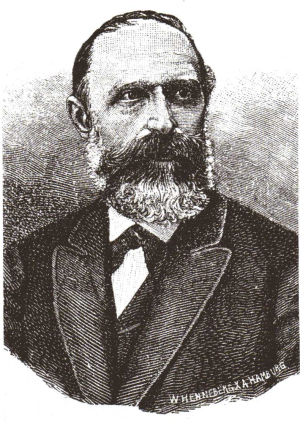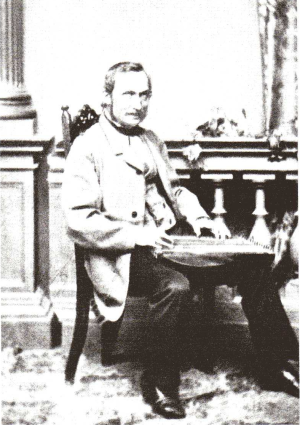Unsatisfied with the lack of uniformity and range of the zither of his time, Nikolaus Weigel introduced a series of innovations which served to expand its capabilities. In this article, Petra Hamberger explores the life of this modest musical pioneer whose discoveries we can appreciate even today. Originally published in the March-April 2008 issue of Saitenspiel, this article has been translated from the original German by Jane Curtis.

Hardly anyone knows the name of this man these days, and yet we all play the zither using his discovery: a logically organized way of tuning the accompaniment strings on the basis of the circle of fourths and fifths, in which all the tones of the chromatic scale are available with no gaps. The impetus to look more closely into Weigel’s life has come from Michael Brandlmeier’s donation of Weigel’s original passport to the archive of the DZB [Deutscher Zither-Bund] in Trossingen.
The passport was issued by the Royal Bavarian “Polizey-Direction” on 2 August 1860, valid for one year. It then had to be “seen”, i.e. approved, by the Royal Bavarian Government of Upper Bavaria –Department of the Interior, the Royal Bavarian Foreign Ministry, the Imperial and Royal Austrian Embassy, and the Belgian Consulate. Only after the passport had been stamped (on the reverse side) by these offices could Nikolaus[1] Weigel and his wife Cecelia begin their journey through Switzerland, France, and Belgium.
The passport guaranteed that he was “to be allowed to travel freely and safely and to be granted any protection and support that might be needed”. In return: “The holder is obliged to present the passport to every Royal Bavarian Embassy and every Royal Consulate whose territory he enters.”

The purpose of this lengthy journey could unfortunately not be discovered, despite intensive research. This is because during Weigel’s lifetime and until his death on 18 January 1878, nothing appeared in print about the zither and its players. The first sources, which are still consulted today, were not written until Nikolaus Weigel had been dead for over six years:
- Baczynski Ritter von Leszkowicz, Raimund:
“Für Freunde der Zither”,
published by the “Echo vom Gebirge” press,
Bad Tölz, 1884
Bennert, Julius Eduard:
“Illustrirte Geschichte der Zither”,
published by the J W Stomps press,
Luxemburg, 1884
These two writers had little to say about Weigel, as he had already been leading a very withdrawn life for many years. Only one authentic biography has survived, written by Max Albert[2] , Senior President of the Verband Deutscher Zithervereine, the earliest predecessor of the Deutscher Zithermusik-Bund, and published in Centralblatt, the Verein’s publication (Vol I. 1878, Nr 2, page 17). The reasons for Weigel’s withdrawal are clearly described here:
- …Like all pioneering spirits, Weigel was not spared by those who undervalued him, failed to understand him, and decried him as “crazy” because of his plans and efforts to carry the zither to a higher stage of development. Unfortunately he was too modest and too lacking in energy to take appropriate action against such limited judgments. On the contrary, Weigel let himself be intimidated and at the same time neglected to obtain advanced training in his chosen field and advanced technical training, the only means by which he could have given his convictions the necessary persuasive power and thereby obtained the recognition he deserved. Nevertheless his system of tuning the zither found ever more proponents and imitators, and it is now the basis for all systems of tuning; but he was not able to turn his artistic progress into material gain, and overwhelmed by various circumstances, he lived a withdrawn life and sank more and more into oblivion.

What Weigel did for the zither came at a time when it was almost harder than today to fight opposing customs and preconceived notions. The higher his services to the zither are to be praised, the more is it to be regretted that he, the first to lead the zither into really artistic channels, never received special distinction from any quarter. Being recognized with a mention at the Casseler Congresse was the last ray of joy to bring him cheer.
He was mentioned at the first Kongress der Zithergeschichte in September 1877 with a request for financial support, as he had told Albert beforehand “in what a sad situation he found himself”. Already in the summer of 1877 he had to break off treatment for rheumatic arthritis because of “lack of means”. A renewed attack of the illness left him unable to recover. A request for donations by his friend Max Albert in the Centralblatt came too late, and it remained only to publish his obituary. This biography appeared as a memorial, mentioning Weigel’s pioneering discovery (Centralblatt Vol I. 1878, Nr 2, page 17):
- Nikolaus Weigel, born 11 December 1811 in Hainau-bei-Landau in the Rheinpfalz, came to Giesing-bei-Munich with his parents in 1822, where his father became a farm manager and mayor. Confined to his room for some time because of an accident in 1830 – he had fallen from a horse and broken his leg, Weigel used the time to study the zither with help from his sister, who had some degree of proficiency in playing it. He soon achieved some skill and came to love the zither so much that he decided to devote himself to it completely. He was not satisfied with the defective tuning and playing system current at the time, but he found his musical knowledge insufficient to perfect the instrument on his own. He wished to make all chords and scales playable in the bass. It was the scholarly advice of C R Weingärtner, a student of Ett’s, that led him to the idea of applying the circle of fifths to the zither. The first zither to be strung with this tuning was made by Ignaz Simon in Haidhausen-bei-Munich following instructions from Weigel.
In 1838 Weigel published the first manual for zither. Since no publisher could be found for the work, and the music dealer Joseph Aibl even laughed at him for it because he wanted to play the zither “from printed music”, Weigel was forced to have it printed at his own expense. This first and oldest of all extant zither manuals contains not only the various “ways of striking” (= playing techniques) but also everything needed, if applied intelligently, for development to the highest level. A revised edition was published by Falter & Son in Munich, with a copyright date of 25 July 1844. The company bookkeeper, F Mayer, found it necessary to justify the publishing of the work for a fee of 100 florins “since it certainly won’t cause the company’s ruin”.
This second edition already contains the exact version of the stringing in use today!

[1] Author’s note: The various sources show two spellings: While the 1860 passport has Nikolaus Weigel, the spelling Nicolaus Weigel appears in other sources.
[2] Translator’s note: Max Albert (1838-1882) was a prominent zither composer and player, very active in organizing various zither societies and publication.
Have you written, or are you aware of, an article which explores the life of a famous zither personality? If so, contact us.
